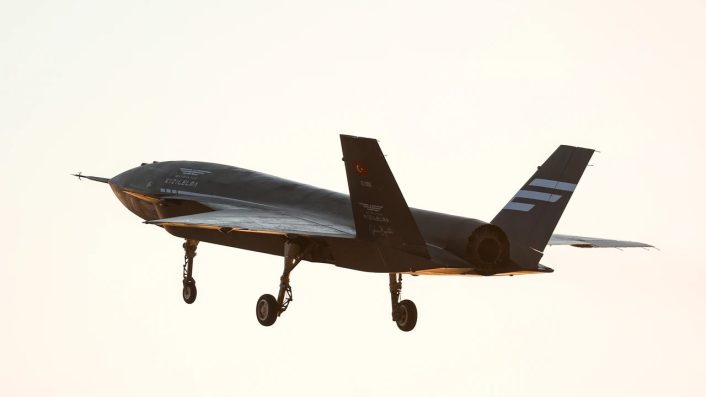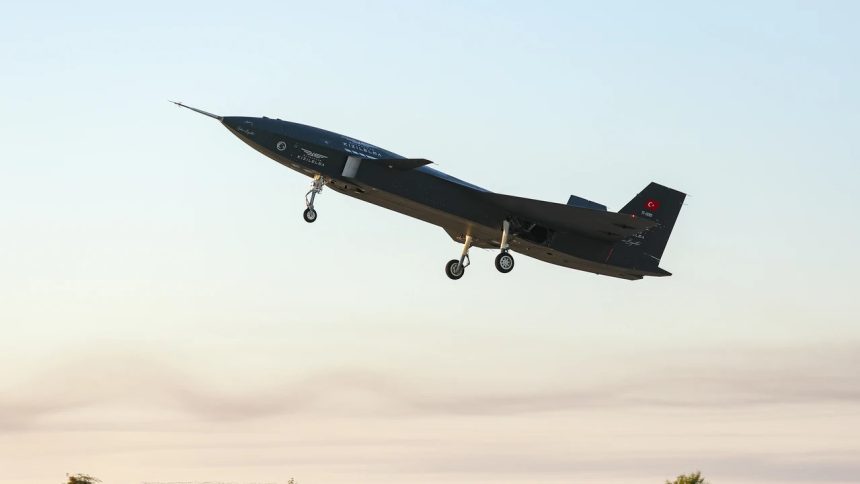The third prototype of Kizilelma is also the production prototype, which shows a number of changes, including an afterburning engine, structural differences and aerodynamic improvements for higher performance.
The production prototype of Turkey’s Kizilelma Unmanned Combat Aerial Vehicle (UCAV) flew its first, short flight on Sep. 25, 2024 from Corlu, the company announced. This design turned out to be a configuration The Aviationist had reported on Jul. 11, which was seen during a diplomatic visit by a delegation from the Kingdom of Saudi Arabia (KSA) to Baykar’s facility.
The new prototype, the third overall and bearing the tail number TC-ÖZB3, showed “significant structural and airframe differences” from the original one, according to the company. The original Kizilelma first flew on Dec. 14, 2022 with the first prototype TC-OZB.
“The third prototype, which is the production prototype of Bayraktar Kızılelma, successfully completed its first flight today,” said the firm’s Chief Technology Officer (CTO), Selçuk Bayraktar. “It was a short test flight. Our tests will continue from now on.”
The design differences noted in The Aviationist’s report were also seen, with the new photos and flight video from various angles shedding even more light on the significant changes in appearance – and possibly even performance capabilities.
In addition to structural improvements, improvements were made to the avionics architecture, said the producer. The flight was performed with the afterburner engine alternative, according to the press release, which will allow Kizilelma to approach the speed of sound and to maneuver much better at high speeds thanks to aerodynamic improvements.
The UCAV, along with the Turkish Aerospace Industries (TAI) Anka-3, is being pushed as a collaborative loyal wingman meant for Manned-Unmanned Teaming (MUM-T) operations with the KAAN fifth generation stealth fighter, and is expected to even undertake air-to-air combat roles. Along with the Anka III, Baykar TB-3 and a naval version of the Hurjet, Kizilelma is also planned to operate from the TCG Anadolu amphibious ship and drone/helicopter carrier.
Bayraktar #KIZILELMA PT-3 Üretim Prototipi ✈️🚀🍎
✅ İlk Uçuş Testi
✅ First Flight Test#MilliTeknolojiHamlesi 🌍🇹🇷 pic.twitter.com/zKfJ5xdjbf
— BAYKAR (@BaykarTech) September 25, 2024
The single-engine delta-canard UCAV is said to have Low Observability (LO) features. A few Turkish reports and defense commentators have claimed that the developer is refining some of its “Artificial Intelligence-enabled features” for “autonomous” combat operations with “minimal” human intervention. TurDef added that the aircraft will come in three versions: the subsonic Kizilelma-A; the supersonic Kizilelma -B; and the twin-engined Kizilelma-C.
Test flight and design
In the video of the maiden flight, the UCAV is seen taxing on the runway, before taking off. As usual for the first flight of a prototype, the aircraft has its landing gear extended throughout the duration of the clip. A thermal mode footage, possibly from an unidentified chase aircraft or another drone, captured Kizilelma flying over a large town, before it coming back to the airfield.
Third prototype of Bayraktar #KIZILELMA (PT-3) made its maiden flight today 🇹🇷🛫 pic.twitter.com/zpk6pG0CVT
— Aero Cadre (@GDI_Aero) September 25, 2024
We had already noted on the first prototypes how the top part of the engine’s air intake is flush with the fuselage, whereas in the new one the top part of the air intake slopes downwards. This also marked a departure from the streamlined wing and body design that characterized the original prototype, with the air inlet and duct appearing almost like a separate body.
The top fuselage, engine and wing assembly sections also appear to be slightly sectioned and separate. A more pronounced bulge visible in the fuselage’s front section could possibly be meant to house the MURAD-200A AESA (Active Electronically Scanned Array) radar. Earlier reports said that the Aselsan-made MURAD was integrated into the Akinci and is also “critical for platforms such as the Kizilelma, KAAN, Hurjet and Anka-3.”

Additionally, the spine extends into the rear section, forming what appears to be a more pronounced tubular section housing the engine exhaust, which is also now considerably above the triangular sections supporting the v-tails’ joints. The outer hull of the exhaust nozzle is also serrated, while the core nozzle itself appears to be a variable geometry nozzle.
One of the most notable differences is the actuators that operate the control surfaces, which were exposed on the first prototype, are now concealed inside the tail section, reducing the Radar Cross Section (RCS).
Bu sabah. This morning. 🍎
Bayraktar #KIZILELMA pic.twitter.com/p0GIXBGrxS
— Selçuk Bayraktar (@Selcuk) September 20, 2024
This aspect was already seen in the PT-3’s engine run test in July, which used a locally-developed afterburner engine. Other previous ground tests, according to Turkiye Today, comprised “automatic taxing acceleration and wheel liftoff.” Selçuk Bayraktar released a video of this test on Sep. 18, showing the Kizilelma taking off for a short hop in a pitched up attitude just a few feet above the runway, before landing again. It is unclear if the UCAV performed this maneuver autonomously.
#Kizilelma Unmanned Combat Air Vehicle is set to revolutionize modern warfare with its advanced stealth and strike capabilities. Designed for autonomous missions, it is equipped to conduct air-to-air and air-to-ground combat, making it a formidable asset in the future of aerial… pic.twitter.com/NH9q3fp1N2
— International Defence Analysis (@Defence_IDA) September 20, 2024
Sensors and engine
The new Ukrainian AI-322 engine will take the Kizilelma to supersonic speeds, which thanks to aerodynamic improvements, will be able to maneuver much better at high speeds, says the developer. The previous AI-25TLT medium-bypass turbofan, has a lower maximum thrust of 16.9 kN.
The MURAD 200-A AESA radar meanwhile offers better situational awareness that aids performance in “challenging missions.” The third prototype also has provisions of defensive and survivability suites like Aselsan’s KARAT-100 Infra-Red Search and Track (IRST), and TOYGUN-100 Electro-Optical Tracking System (IRST). Other posts on X by Turkish defense handles also note a Distributed Aperture System (DAS) and an IRIS Missile Approach Warning System (MAWS) on the airframe.









